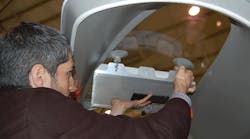UAV Antenna Changes Beam Direction in 1/1000th of a Second
A software-defined, electronically reconfigurable Agile Aperture Antenna (A3)—successfully tested on land, sea, and air—will ultimately find homes in unmanned aerial vehicles (UAVs) with small power supplies and limited surface area for integrating antennas. Developed by the Georgia Tech Research Institute (GTRI), the lightweight and low power antenna can change beam directions in a thousandth of a second. During the test, one antenna (looking upward) maintained a satellite data connection as an aircraft changed headings while another antenna (looking downward) tracked electromagnetic emitters on the ground.
In conjunction with rapidly altering beam direction, the device’s frequency and polarization can be changed by switching active components. The prototype used in the test operates from 500 to 3000 MHz with ±60° hemispherical view. A newer prototype can potentially provide gain to 6 GHz, opening up more communication options. For the test, GTRI joined forces with SR Technologies Inc. (SRT), which provided mobile communications hardware that includes an L-band mobile satellite and Wi-Fi and cellular solutions.
Before takeoff, the research team programmed the satellite’s location into the device. The antennas tracked the satellite using an inertial measurement unit that provided pitch, roll, yaw, longitude, latitude, and altitude data. The data was then sent to a controller, which turned elements on and off to change beam direction and maintain communication.
Since the A3 doesn’t require the mechanical movement of a metal dish, it can change beam direction 120° in a thousandth of a second—a major advantage over traditional gimbaled antennas. A cooling system isn’t required thanks to the antenna’s low power consumption. Composed of printed circuit boards and weighing only two to three pounds, it’s lighter and less complex than phased-array antennas with similar capabilities. In addition, unlike phased arrays that must feed and control each element separately, the A3 uses only one static feed point.
The A3 was previously tested on a Wave Glider autonomous ocean vehicle as well as a moving ground vehicle—and now a UAV—to demonstrate its flexibility. According to GTRI, although the antenna is ideal for such vehicles, its concept could be adapted to mobile devices where dynamic tenability could help cut through cellular network congestion. It also can be retrofitted into existing systems, saving fabrication and other costs.


